Recycled Untreated Rubber Waste for Controlling the Alkali–Silica Reaction in Concrete
Abstract
1. Introduction
| Sr. No. | Structures | Location | References |
|---|---|---|---|
| 1 | Retaining wall and piers | Japan | Ono [4] |
| 2 | turbine foundation, Ikata power plant | Japan | Takakura et al. [5] |
| 3 | Bridge piers of Hanshin Super highway | Japan | Miyagawa et al. [6] |
| 4 | Hokuriku Expressway | Japan | Moriyama and Nomura [7] |
| 5 | Bibb Graves Bridge | Alabama, USA | Michael et al. [8] |
| 6 | Concrete pavement | Arkansas and Delaware, USA | |
| 7 | Concrete abutments | Rhode Island and Maine, USA | |
| 8 | Concrete barrier walls | Massachusetts, USA | |
| 9 | Bridge columns | Houstan, Texas, USA | |
| 10 | Seabrook Nuclear Power Plant | New Hampshire, USA | Saouma et al. [9] |
| 11 | Flyover bridge | Aarhus, Denmark | Schmidt et al. [10] |
| 12 | Vosnasvej Bridge | Denmark | Gustenhoff et al. [11] |
| 13 | Robert-Bourassa/Charest overpass | Quebec City, Canada | Sanchez et al. [12] |
| 14 | Bridge structures | Finland | Lahdensivu et al. [13] |
2. Materials and Casting of Specimens
3. Experimental Methodologies
4. Results and Discussion
4.1. Properties of Raw Materials
4.2. Flow of Mixtures Incorporating Recycled Rubber Waste
4.3. Density
4.4. Thermal Analysis
4.5. Effect of Recycled Rubber Waste on Compressive and Flexural Strengths
4.6. Expansion Due to ASR
4.7. Effect of ASR on Compressive and Flexural Strengths
4.8. Micro-Structural Analysis
5. Conclusions
- Mixtures incorporating RW showed decreased flow compared to that of the identical mixture without RW. For example, the control mixture exhibited a flow of 114 mm while the mixture with 15% of RW showed a flow of 105 mm. This was due to interfacial properties between the rubber particles and the matrix. Furthermore, the rougher surface of rubber particles hinders the flow properties of the tested mixtures.
- The density of mixtures with RW had shown a decreasing trend due to the lower value of the specific gravity of rubber particles. Furthermore, mixtures incorporating RW can entrap air at the surface of the rubber particles due to its jagged texture, leading to a reduction in the unit weight and density.
- Compressive strength was decreased for specimens incorporating RW compared to that of the identical specimens without RW at all the tested ages. For example, around a 24% decrease in compressive strength at 28 days was observed for specimens with 10% of RW by volume compared to that of the control specimen. This decrease was higher for specimens incorporating higher proportions of RW. A maximum compressive strength decrease of around 47% was observed at 150 days for specimens incorporating 25% of RW compared to identical specimens without RW. This reduction in compressive strength for specimens incorporating RW was attributed to weaker bonds between the rubber particles and the matrix.
- A decreasing trend in flexural strength was observed due to incorporation of RW. For instance, a decrease in flexural strength of around 8% was observed for specimens incorporating 5% of RW by volume of aggregates compared to that of the control specimens. A maximum decrease in flexural strength was reported for the mixture with 25% of RW. The irregular nature of used RW will make a weaker link between the rubber particles and the matrix, leading to a decrease in the flexural strength for specimens incorporating RW.
- Control specimens without RW showed expansions of 0.232% and 0.284% at 14 days and 28 days, respectively, indicating the reactive nature with respect to ASTM C1260. Expansion was decreased for specimens incorporating RW. For instance, mortar bars incorporating 5% of RW showed expansions of 0.20% and 0.26% at 14 days and 28 days, respectively. The mixture with 20% and 25% of RW by aggregate volume showed the expansion values lower than 0.20% at 28 days, satisfying the ASTM C1260 limit for non-reactive ASR nature. This decrease in ASR expansion for mixtures incorporating RW was mainly due to the elastic behavior of rubber that ensures the dissipation of expansion stresses, initiated due to the formation of ASR gel.
- The compressive and flexural strengths of specimens exposed to an ASR environment have shown a decreased behavior compared to identical specimens placed in water curing. For example, control specimens without RW subjected to ASR conditions showed a reduction in the compressive strength of 15% at 150 days, respectively, compared to that of the identical specimen under a normal curing regime. A maximum decrease in compressive strength of around 20% at 150 days was observed for specimens incorporating 25% of RW by volume of aggregates exposed to ASR conditions compared to that of the identical specimen placed in normal curing.
- Micro-structural analysis of specimens incorporating RW showed no surface cracking, although ASR gel formation was observed. However, control specimens without RW showed severe micro-cracks due to ASR.
Author Contributions
Funding
Institutional Review Board Statement
Informed Consent Statement
Data Availability Statement
Acknowledgments
Conflicts of Interest
References
- ACI Committee. 221: State-of-the-Art Report on Alkali-Aggregate Reactivity; American Concrete Institute: Farmington Hills, MI, USA, 1998; pp. 1–23. [Google Scholar]
- Thomas, M.D.A.; Fournier, B.; Folliard, K.J. Alkali-Aggregate Reactivity (AAR) Facts Book; FHWA-HIF-13-019; Federal Highway Administration, Office of Pavement Technology: Washington, DC, USA, 2013; 224p.
- Munir, M.J.; Qazi, A.U.; Kazmi, S.M.S.; Khitab, A.; Ashiq, S.Z.; Ahmed, I. A literature review on alkali silica reactivity of concrete. Pakistan. Pak J. Sci. 2016, 68, 53–62. [Google Scholar] [CrossRef]
- Ono, K. Damaged concrete structures in Japan due to alkali silica reaction. Int. J. Cem. Compos. Lightweight Concr. 1998, 10, 11. [Google Scholar] [CrossRef]
- Takakura, T.; Ishikawa, T.; Mitsuki, S.; Matsumoto, N.; Takiguchi, K.; Masuda, Y.; Nishiguchi, I. Investigation on the expansion value of turbine generator foundation affected by alkali-silica reaction. In Proceedings of the 18th International Conference on Structural Mechanics in Reactor Technology (SMiRT), Beijing, China, 7–12 August 2005; pp. 2061–2068. [Google Scholar]
- Miyagawa, T.; Seto, K.; Sasaki, K.; Mikata, Y.; Kuzume, K.; Minami, T. Fracture of reinforcing steels in concrete structures damaged by ASR. In Proceedings of the 7th ACI International Conference on Durability of Concrete, Montreal, QC, Canada, 28 May–3 June 2006. 9p. [Google Scholar]
- Moriyama, M.; Nomura, M. Maintenance of ASR-Affected Structures in Hokuriku Expressway, Japan. Available online: https://www.pwri.go.jp/eng/ujnr/tc/g/pdf/27/27-4-3_Moriyama.pdf (accessed on 13 January 2020).
- Michael, T.; Folliard, K.; Fournier, B.; Rivard, P.; Drimalas, T. Methods for Evaluating and Treating ASR-Affected Structures: Results of Field Application and Demonstration Projects—Volume I: Summary of Findings and Recommendations; Report No. FHWA-HIF-14-0002; Federal Highway Administration, Office of Pavement Technology: Washington, DC, USA, 2013; 80p.
- Saouma, V.E.; Hariri-Ardebili, A. A proposed aging management program for alkali silica reactions in a nuclear power plant. Nucl. Eng. Des. 2014, 277, 248–264. [Google Scholar] [CrossRef]
- Schmidt, J.W.; Hansen, S.G.; Barbosa, R.A.; Henriksen, A. Novel shear capacity testing of ASR damaged full scale concrete bridge. Eng. Struct. 2014, 79, 365–374. [Google Scholar] [CrossRef]
- Gustenhoff, H.; Antonio, B.; Cao, H.; Kielsgaard, H. Shear capacity of ASR damaged structures—In-depth analysis of some in-situ shear tests on bridge slabs. In Proceedings of the 15th International Conference on Alkali-Aggregate Reaction in Concrete (ICAAR), Sao Paulo, Brazil, 3–7 July 2016. 11p. [Google Scholar]
- Sanchez, L.F.M.; Fournier, B.; Jolin, M.; Bastien, J.; Mitchell, D. Tools for assessing damage in concrete affected by AAR coming from fine and coarse aggregates. Ibracon Struct. Mater. J. 2017, 10, 84–91. [Google Scholar] [CrossRef][Green Version]
- Lahdensivu, J.; Husaini, A. Alkali-silica reaction in Southern-Finland’s bridges. Case Stud. Constr. Mater. 2018, 8, 469–475. [Google Scholar] [CrossRef]
- Thomas, M.D.A. Field studies of fly ash concrete structures containing reactive aggregates. Mag. Concr. Res. 1996, 48, 265–279. [Google Scholar] [CrossRef]
- Wedding, P.; Dunstan, E. The Effect of Fly Ash on Concrete Alkali-Aggregate Reaction. Cem. Concr. Aggreg. 1981, 3, 101. [Google Scholar] [CrossRef]
- Lumley, J.S. The ASR expansion of concrete prisms made from cements partially replaced by ground granulated blast furnace slag. Constr. Build. Mater. 1993, 7, 95–99. [Google Scholar] [CrossRef]
- Boddy, A.; Hooton, R.D.; Thomas, M. The effect of the silica content of silica fume on its ability to control alkali–silica reaction. Cem. Concr. Res. 2003, 33, 1263–1268. [Google Scholar] [CrossRef]
- Aquino, W.; Lange, D.; Olek, J. The influence of metakaolin and silica fume on the chemistry of alkali–silica reaction products. Cem. Concr. Compos. 2001, 23, 485–493. [Google Scholar] [CrossRef]
- Abbas, S.; Kazmi, S.M.; Munir, M.J. Potential of rice husk ash for mitigating the alkali-silica reaction in mortar bars incorporating reactive aggregates. Constr. Build. Mater. 2017, 132, 61–70. [Google Scholar] [CrossRef]
- Abbas, S.; Sharif, A.; Ahmed, A.; Abbass, W.; Shaukat, S. Prospective of sugarcane bagasse ash for controlling the alkali-silica reaction in concrete incorporating reactive aggregates. Struct. Concr. 2019, 21, 781–793. [Google Scholar] [CrossRef]
- Liu, S.; Wang, S.; Tang, W.; Hu, N.; Wei, J. Inhibitory Effect of Waste Glass Powder on ASR Expansion Induced by Waste Glass Aggregate. Materials 2015, 8, 6849–6862. [Google Scholar] [CrossRef] [PubMed]
- Shafaatian, S.M.; Akhavan, A.; Maraghechi, H.; Rajabipour, F. How does fly ash mitigate alkali–silica reaction (ASR) in accelerated mortar bar test (ASTM C1567)? Cem. Concr. Compos. 2013, 37, 143–153. [Google Scholar] [CrossRef]
- Johari, M.A.M.; Brooks, J.; Kabir, S.; Rivard, P. Influence of supplementary cementitious materials on engineering properties of high strength concrete. Constr. Build. Mater. 2011, 25, 2639–2648. [Google Scholar] [CrossRef]
- Abbas, S.; Ahmed, A.; Nehdi, M.L.; Saeed, D.; Abbass, W.; Amin, F. Eco-Friendly Mitigation of Alkali-Silica Reaction in Concrete Using Waste-Marble Powder. J. Mater. Civ. Eng. 2020, 32, 04020270. [Google Scholar] [CrossRef]
- Zapała-Sławeta, J.; Owsiak, Z. The role of lithium compounds in mitigating alkali-gravel aggregate reaction. Constr. Build. Mater. 2016, 115, 299–303. [Google Scholar] [CrossRef]
- Tremblay, C.; Bérubé, M.A.; Fournier, B.; Thomas, M.D.; Folliard, K.J. Effectiveness of lithium-based products in concrete made with Canadian natural aggregates susceptible to alkali–silica reactivity. ACI Mater. J. 2007, 104, 195–205. [Google Scholar]
- Zapała-Sławeta, J.; Świt, G. Monitoring of the Impact of Lithium Nitrate on the Alkali–aggregate Reaction Using Acoustic Emission Methods. Materials 2018, 12, 20. [Google Scholar] [CrossRef]
- Feng, X.; Thomas, M.; Bremner, T.; Folliard, K.; Fournier, B. New observations on the mechanism of lithium nitrate against alkali silica reaction (ASR). Cem. Concr. Res. 2010, 40, 94–101. [Google Scholar] [CrossRef]
- Jiajian, L.; Shuai, C.; Erol, Y.; Yunpeng, L. Compressive fatigue behavior and failure evolution of additive fiber-reinforced cemented tailings composites. Int. J. Miner. Metall. Mater. 2022, 29, 345–355. [Google Scholar]
- Malarvizhi, G.; Senthil, N.; Kamaraj, C. A study on recycling of crumb rubber and low density polyethylene blend on stone matrix asphalt. Int. J. Sci. Publ. 2012, 2, 1–16. [Google Scholar]
- Thomas, B.S.; Gupta, R.C. A comprehensive review on the applications of waste tire rubber in cement concrete. Renew. Sustain. Energy Rev. 2016, 54, 1323–1333. [Google Scholar] [CrossRef]
- Nehdi, M.; Khan, A. Cementitious Composites Containing Recycled Tire Rubber: An Overview of Engineering Properties and Potential Applications. Cem. Concr. Aggreg. 2001, 23, 3–10. [Google Scholar]
- Xu, J.; Yao, Z.; Yang, G.; Han, Q. Research on crumb rubber concrete: From a multi-scale review. Constr. Build. Mater. 2019, 232, 117282. [Google Scholar] [CrossRef]
- Siddika, A.; Al Mamun, M.A.; Alyousef, R.; Amran, Y.H.M.; Aslani, F.; Alabduljabbar, H. Properties and utilizations of waste tire rubber in concrete: A review. Constr. Build. Mater. 2019, 224, 711–731. [Google Scholar] [CrossRef]
- Najim, K.; Hall, M. A review of the fresh/hardened properties and applications for plain- (PRC) and self-compacting rubberised concrete (SCRC). Constr. Build. Mater. 2010, 24, 2043–2051. [Google Scholar] [CrossRef]
- Topçu, I.B.; Demir, A. Durability of Rubberized Mortar and Concrete. J. Mater. Civ. Eng. 2007, 19, 173–178. [Google Scholar] [CrossRef]
- Ganjian, E.; Khorami, M.; Maghsoudi, A.A. Scrap-tyre-rubber replacement for aggregate and filler in concrete. Constr. Build. Mater. 2009, 23, 1828–1836. [Google Scholar] [CrossRef]
- Gupta, T.; Chaudhary, S.; Sharma, R.K. Assessment of mechanical and durability properties of concrete containing waste rubber tire as fine aggregate. Constr. Build. Mater. 2014, 73, 562–574. [Google Scholar] [CrossRef]
- Oikonomou, N.; Mavridou, S. Improvement of chloride ion penetration resistance in cement mortars modified with rubber from worn automobile tires. Cem. Concr. Compos. 2009, 31, 403–407. [Google Scholar] [CrossRef]
- Ataria, R.B.; Wang, Y.C. Mechanical Properties and Durability Performance of Recycled Aggregate Concrete Containing Crumb Rubber. Materials 2022, 15, 1776. [Google Scholar] [CrossRef] [PubMed]
- Liu, C.S.; Zhu, H.; Li, Z.G.; Zhang, J.; Yuan, L. Research in the fundamental characteristics of crumb rubber mortar. Concrete 2005, 139, 38–42. [Google Scholar]
- Batayneh, M.K.; Marie, I.; Asi, I. Promoting the use of crumb rubber concrete in developing countries. Waste Manag. 2007, 28, 2171–2176. [Google Scholar] [CrossRef]
- Bing, C.; Ning, L. Experimental Research on Properties of Fresh and Hardened Rubberized Concrete. J. Mater. Civ. Eng. 2014, 26, 04014040. [Google Scholar] [CrossRef]
- Afshinnia, K.; Poursaee, A. The influence of waste crumb rubber in reducing the alkali–silica reaction in mortar bars. J. Build. Eng. 2015, 4, 231–236. [Google Scholar] [CrossRef]
- ASTM C1260; Standard Test Method for Potential Alkali Reactivity of Aggregates (Mortar-Bar Method). American Society for Testing and Materials: West Conshohocken, PA, USA, 2014; 5p.
- ASTM C295; Standard Guide for Petrographic Examination of Aggregates for Concrete. American Society for Testing and Materials: West Conshohocken, PA, USA, 2018; 9p.
- ASTM C1437; Standard Test Method for Flow of Hydraulic Cement Mortar. American Society for Testing and Materials: West Conshohocken, PA, USA, 2020; 2p.
- ASTM C191; Standard Test Methods for Time of Setting of Hydraulic Cement by Vicat needle. American Society for Testing and Materials: West Conshohocken, PA, USA, 2021; 8p.
- ASTM C187; Standard Test Method for Amount of Water Required for Normal Consistency of Hydraulic Cement Paste. American Society for Testing and Materials: West Conshohocken, PA, USA, 2016; 3p.
- ASTM C109; Standard Test Method for Compressive Strength of Hydraulic Cement Mortars (Using 2-in. or [50 mm] Cube Specimens). American Society for Testing Materials: West Conshohocken, PA, USA, 2020; 12p.
- ASTM C348; Standard Test Method for Flexural Strength of Hydraulic-Cement Mortars. American Society for Testing Materials: West Conshohocken, PA, USA, 2020; 6p.
- ASTM C490; Standard Practice for Use of Apparatus for the Determination of Length Change of Hardened Cement Paste, Mortar, and Concrete. American Society for Testing Materials: West Conshohocken, PA, USA, 2017; 5p.
- Bisht, K.; Ramana, P. Evaluation of mechanical and durability properties of crumb rubber concrete. Constr. Build. Mater. 2017, 155, 811–817. [Google Scholar] [CrossRef]
- Angelin, A.; Miranda, E.; Dos Santos, J.; Lintz, R.C.C.; Gachet, L.A. Rubberized mortar: The influence of aggregate granulometry in mechanical resistances and acoustic behavior. Constr. Build. Mater. 2018, 200, 248–254. [Google Scholar] [CrossRef]
- Abbas, S.; Arshad, U.; Abbass, W.; Nehdi, M.; Ahmed, A. Recycling Untreated Coal Bottom Ash with Added Value for Mitigating Alkali–Silica Reaction in Concrete: A Sustainable Approach. Sustainability 2020, 12, 10631. [Google Scholar] [CrossRef]
- Abdelmonem, A.; El-Ferky, M.S.; El-Sayed, A.R.; Kohail, M. Performance of high strength concrete containing recycled rubber. Constr. Build. Mater. 2019, 227, 116660. [Google Scholar] [CrossRef]
- Taha, M.M.R.; El-Dieb, A.S.; El-Wahab, M.A.A.; Abdel-Hameed, M.E. Mechanical, Fracture, and Microstructural Investigations of Rubber Concrete. J. Mater. Civ. Eng. 2008, 20, 640–649. [Google Scholar] [CrossRef]
- Chen, F.; Qian, J. Studies of the thermal degradation of waste rubber. Waste Manag. 2003, 23, 463–467. [Google Scholar] [CrossRef]
- Moropoulou, A.; Bakolas, A.; Aggelakopoulou, E. Evaluation of pozzolanic activity of natural and artificial pozzolans by thermal analysis. Thermochim. Acta 2004, 420, 135–140. [Google Scholar] [CrossRef]
- Benazzouk, A.; Douzane, O.; Langlet, T.; Mezreb, K.; Roucoult, J.; Quéneudec, M. Physico-mechanical properties and water absorption of cement composite containing shredded rubber wastes. Cem. Concr. Compos. 2007, 29, 732–740. [Google Scholar] [CrossRef]
- Kwan, A.K.H.; Mckinley, M. Effect of limestone filler on water film thickness, paste film thickness and performance of mortar. Powder Technol. 2014, 261, 33–41. [Google Scholar] [CrossRef]
- RILEM Recommended test method: AAR-2—Detection of potential alkali-reactivity-Accelerated mortar bar test method for aggregates. In RILEM Recommendations for the Prevention of Damage by Alkali-Aggregate Reactions in New Concrete Structures; RILEM State of the Art Reports; Nixon, P.J., Sims, I., Eds.; RILEM: Dordrecht, The Netherlands, 2016. [Google Scholar]
- Australian Standard (AS) 1141.60.1; Method for Sampling and Testing Aggregates, Potential Alkali-Silica Reactivity—Accelerated Mortar bar Method. Standards Australia: Sydney, Australia, 2014.
- Zhu, H. Crumb Rubber Concrete, Rapra Handbook on Polymers Use in Construction; Rapra Technology Limited: Shawbury, UK, 2004. [Google Scholar]
- Abbas, S.; Abbass, W.; Nehdi, M.; Ahmed, A.; Yousaf, M. Investigation of Alkali-Silica Reactivity in Sustainable Ultrahigh Performance Concrete. Sustainability 2021, 13, 5680. [Google Scholar] [CrossRef]
- Yazıcı, H. The effect of steel micro-fibers on ASR expansion and mechanical properties of mortars. Constr. Build. Mater. 2012, 30, 607–615. [Google Scholar] [CrossRef]
- Esposito, R.; Anaç, C.; Hendriks, M.A.N.; Çopuroğlu, O. Influence of the Alkali-Silica Reaction on the Mechanical Degradation of Concrete. J. Mater. Civ. Eng. 2016, 28, 04016007. [Google Scholar] [CrossRef]
- Wang, S. Cofired biomass fly ashes in mortar: Reduction of Alkali Silica Reaction (ASR) expansion, pore solution chemistry and the effects on compressive strength. Constr. Build. Mater. 2015, 82, 123–132. [Google Scholar] [CrossRef]
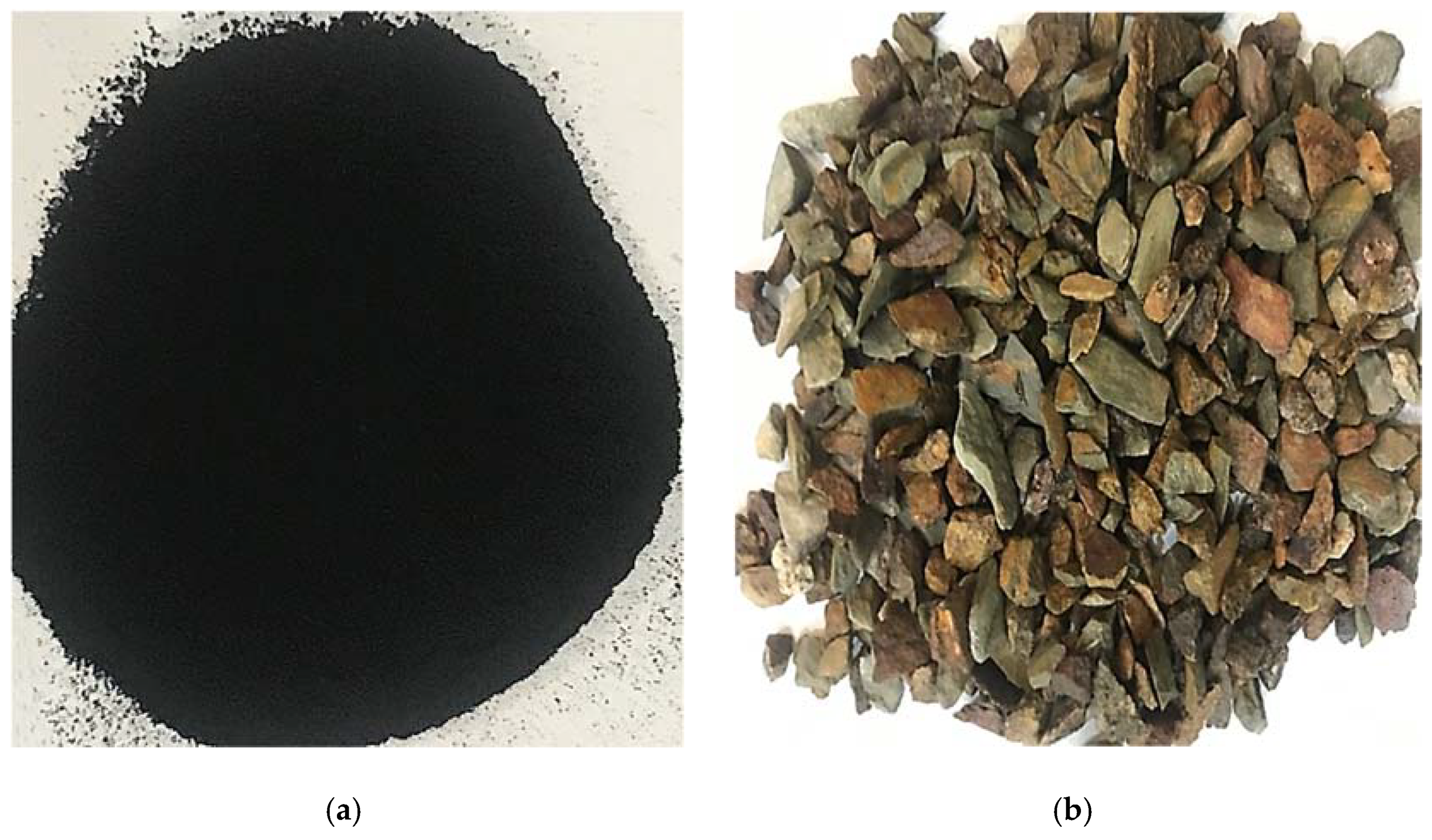

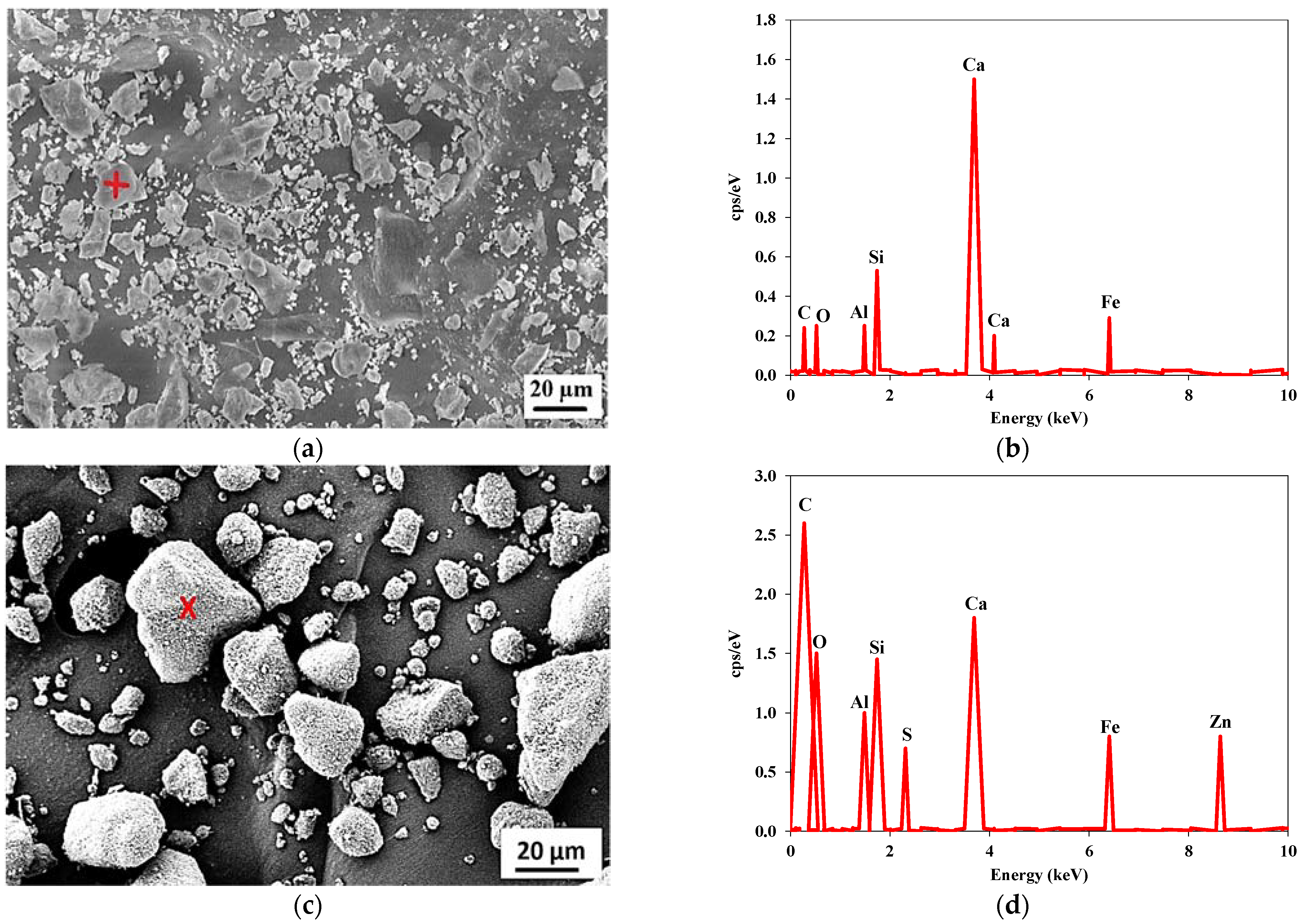

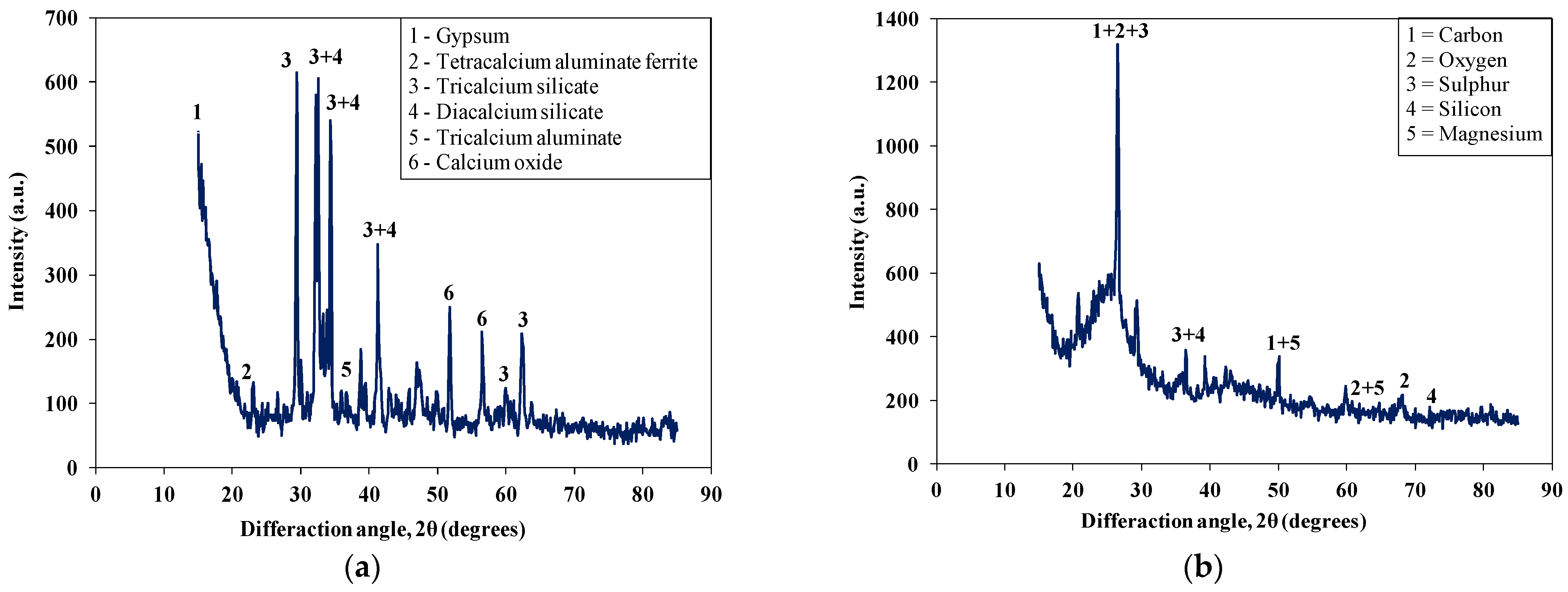
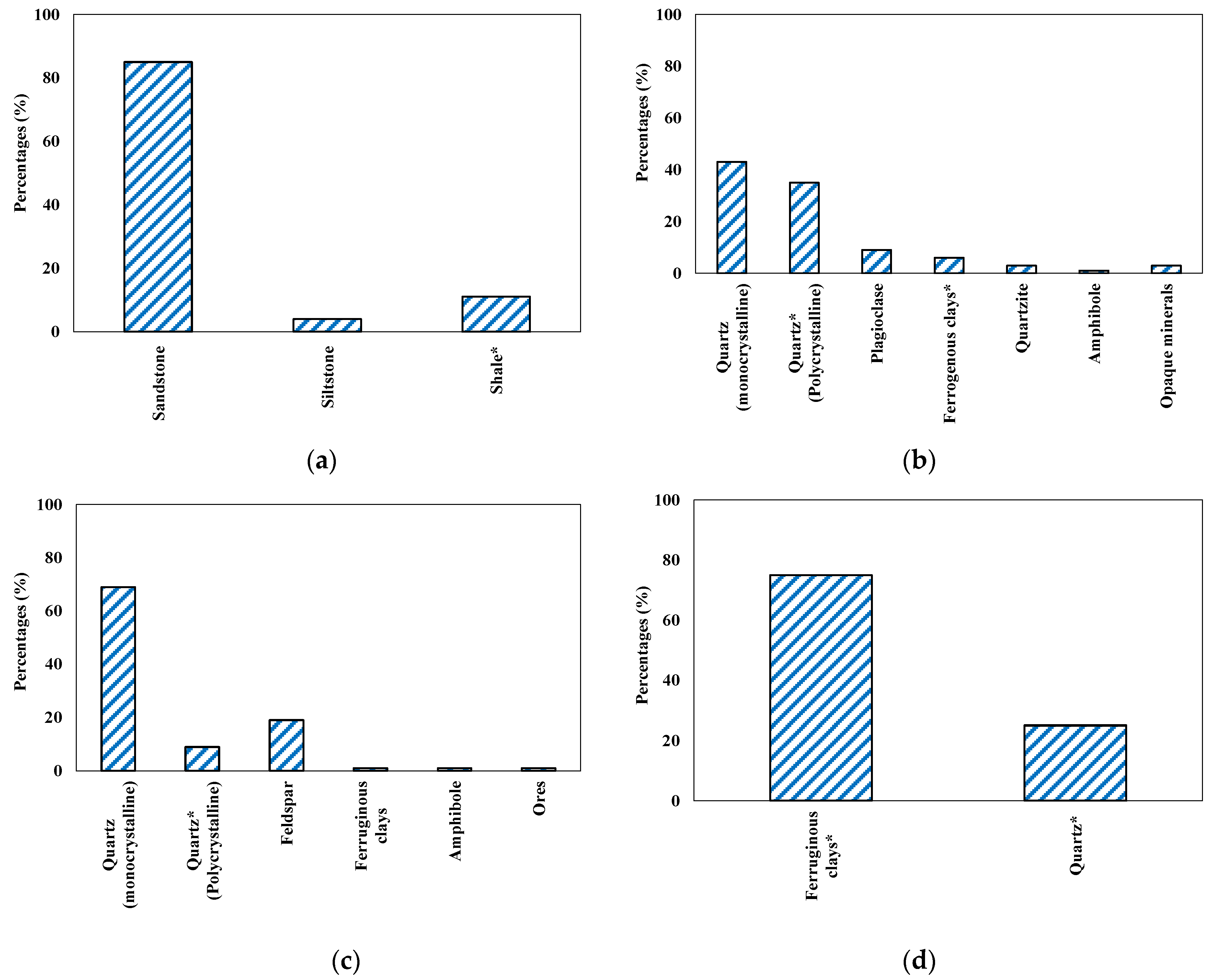
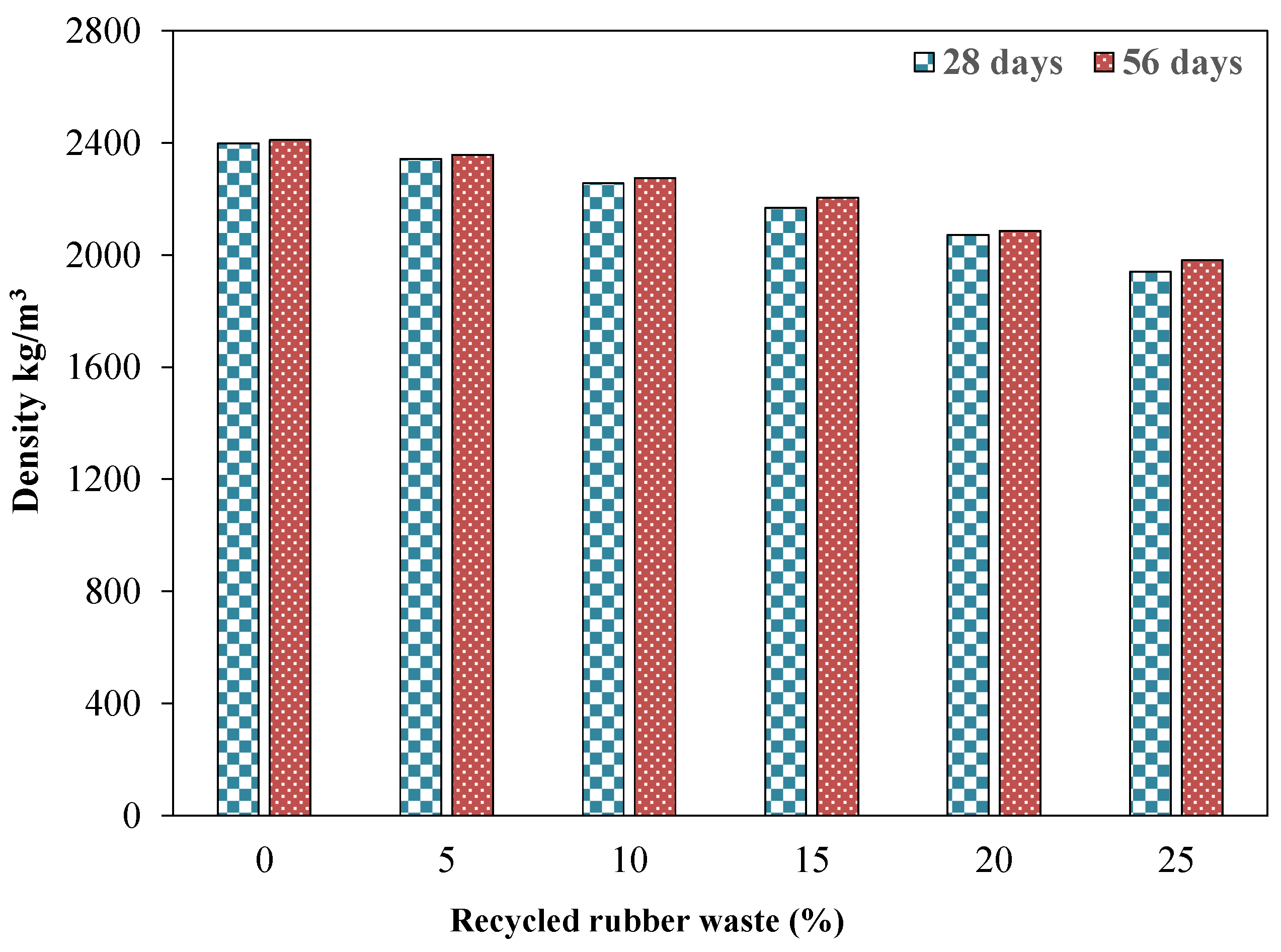
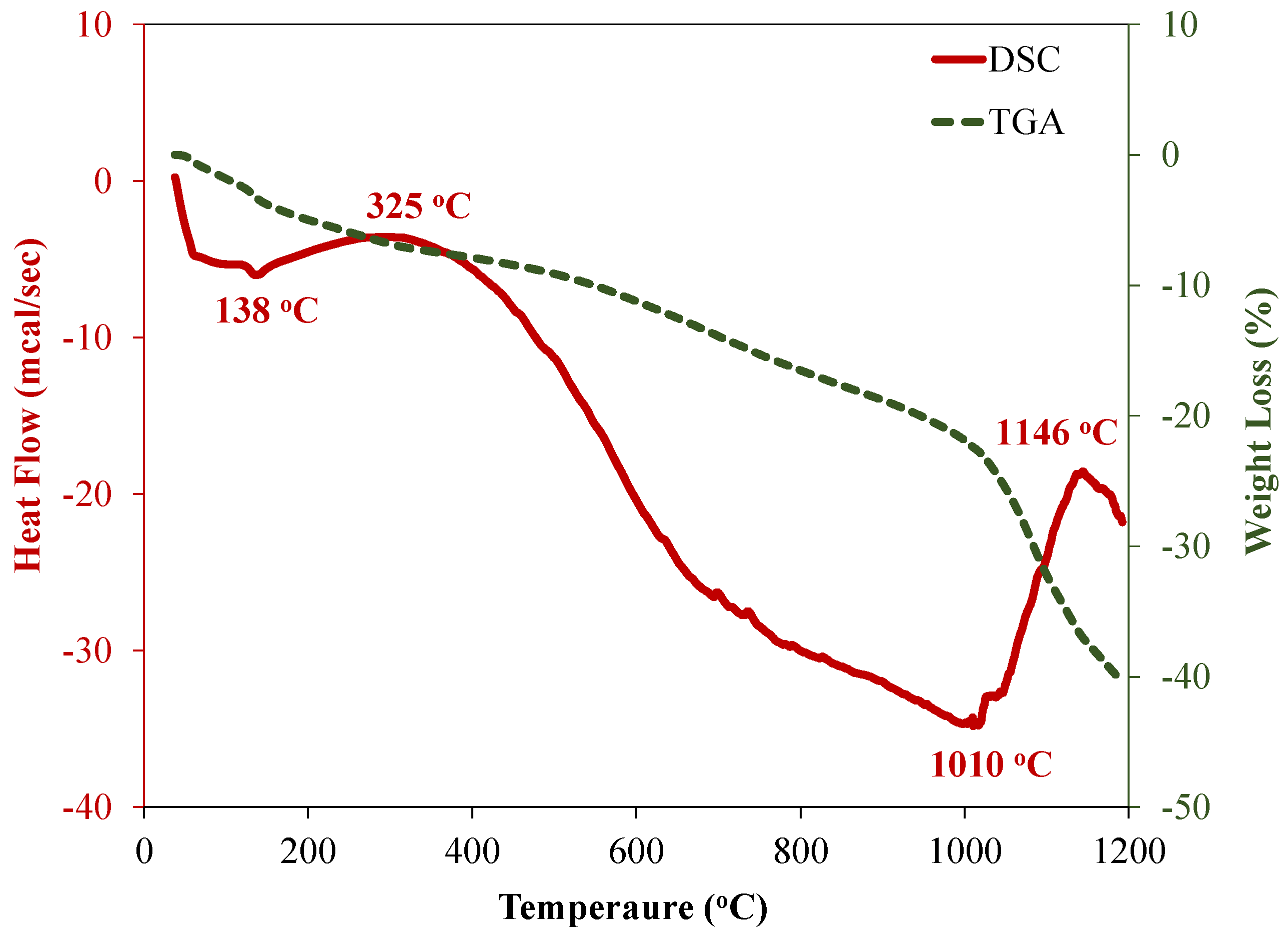
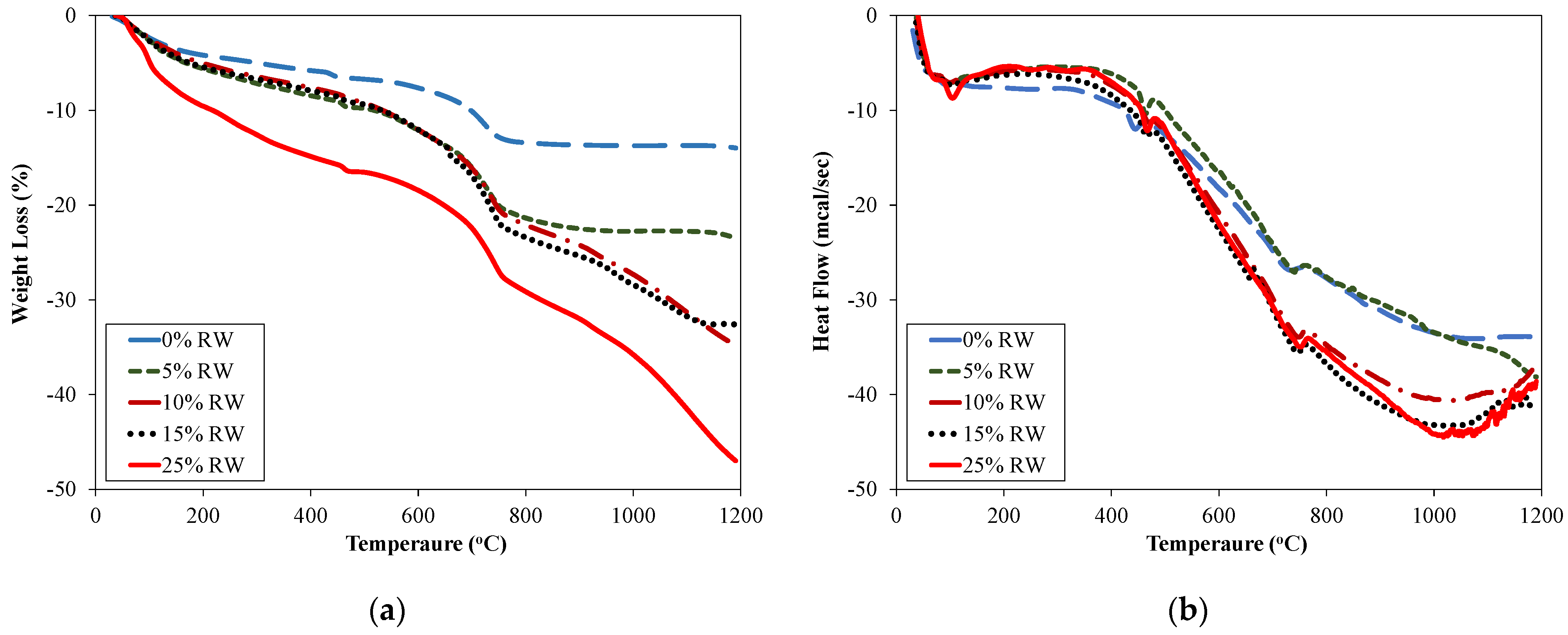

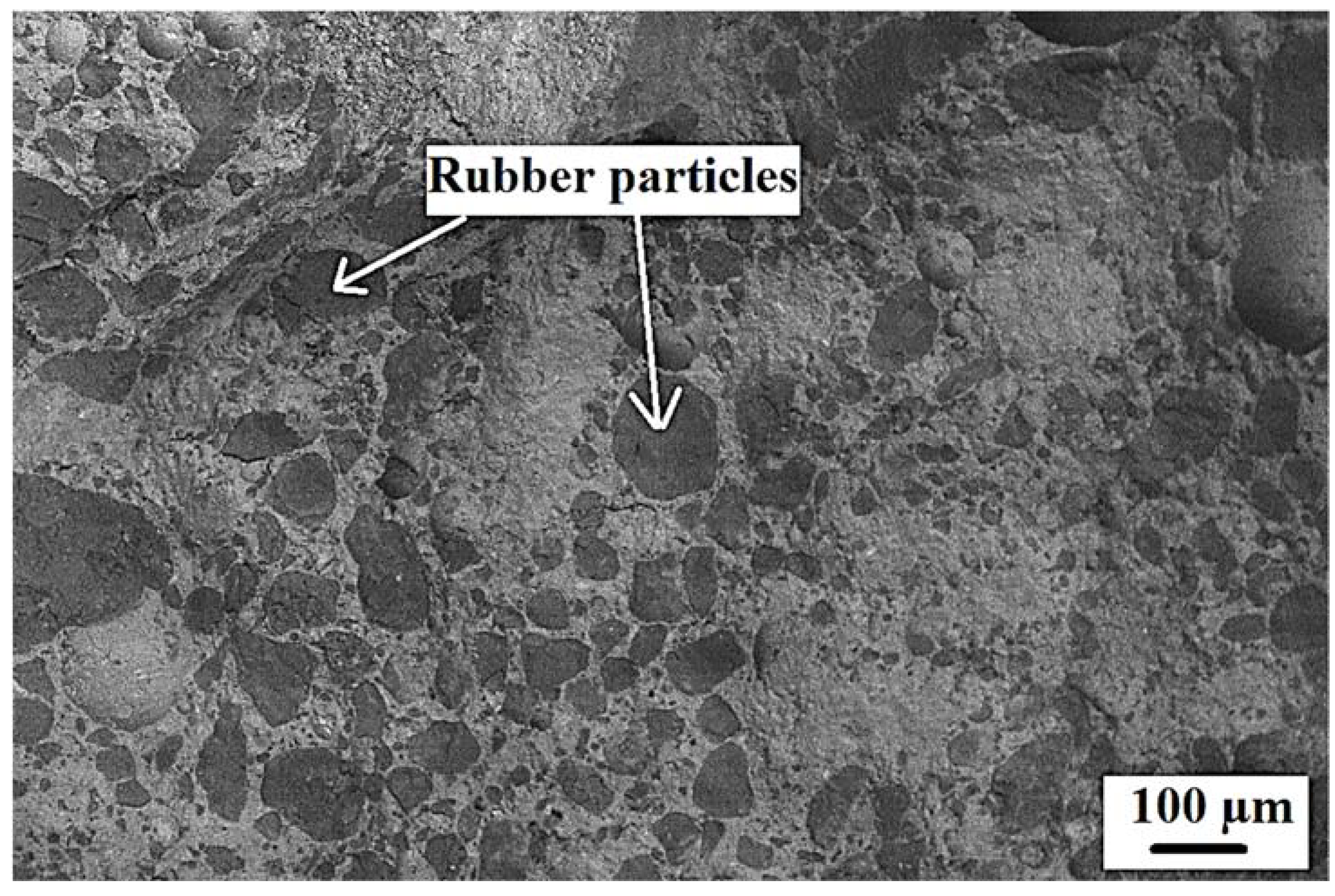
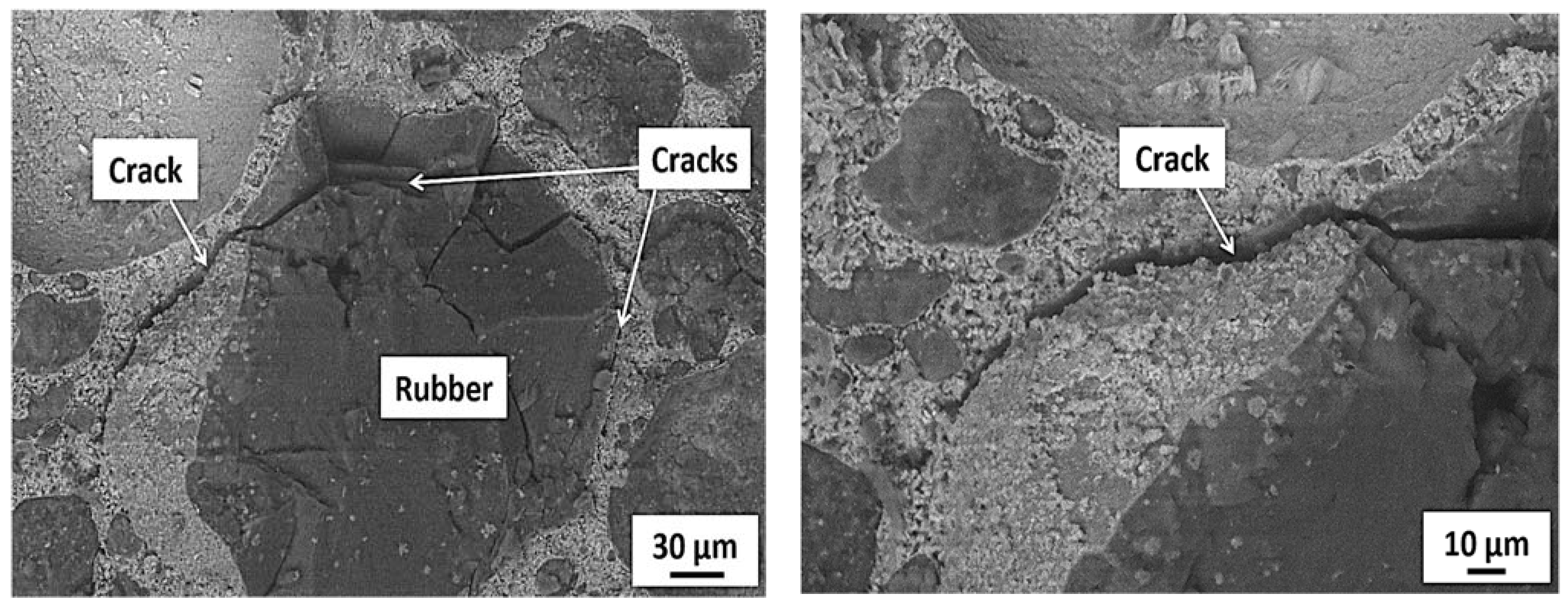
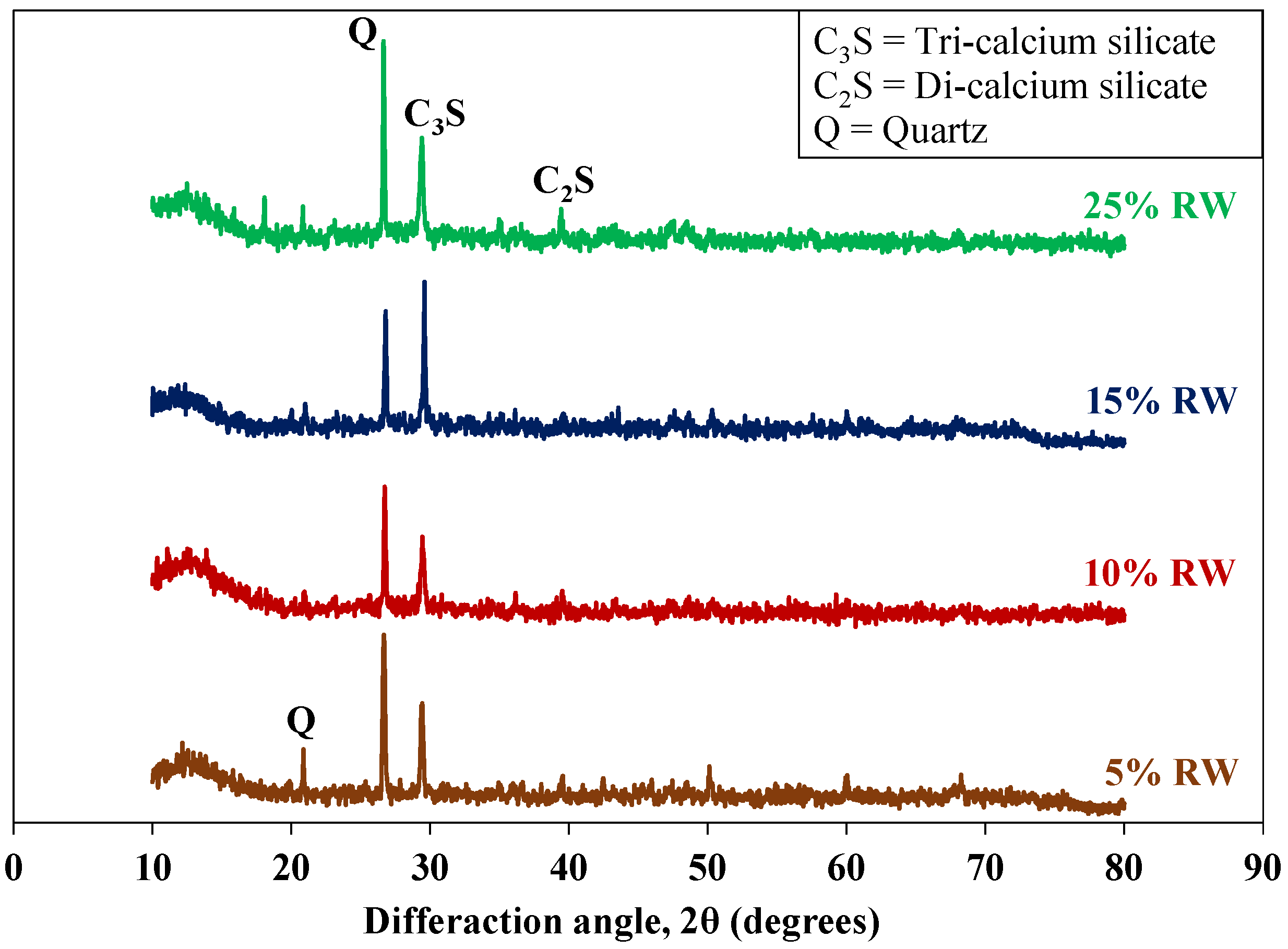

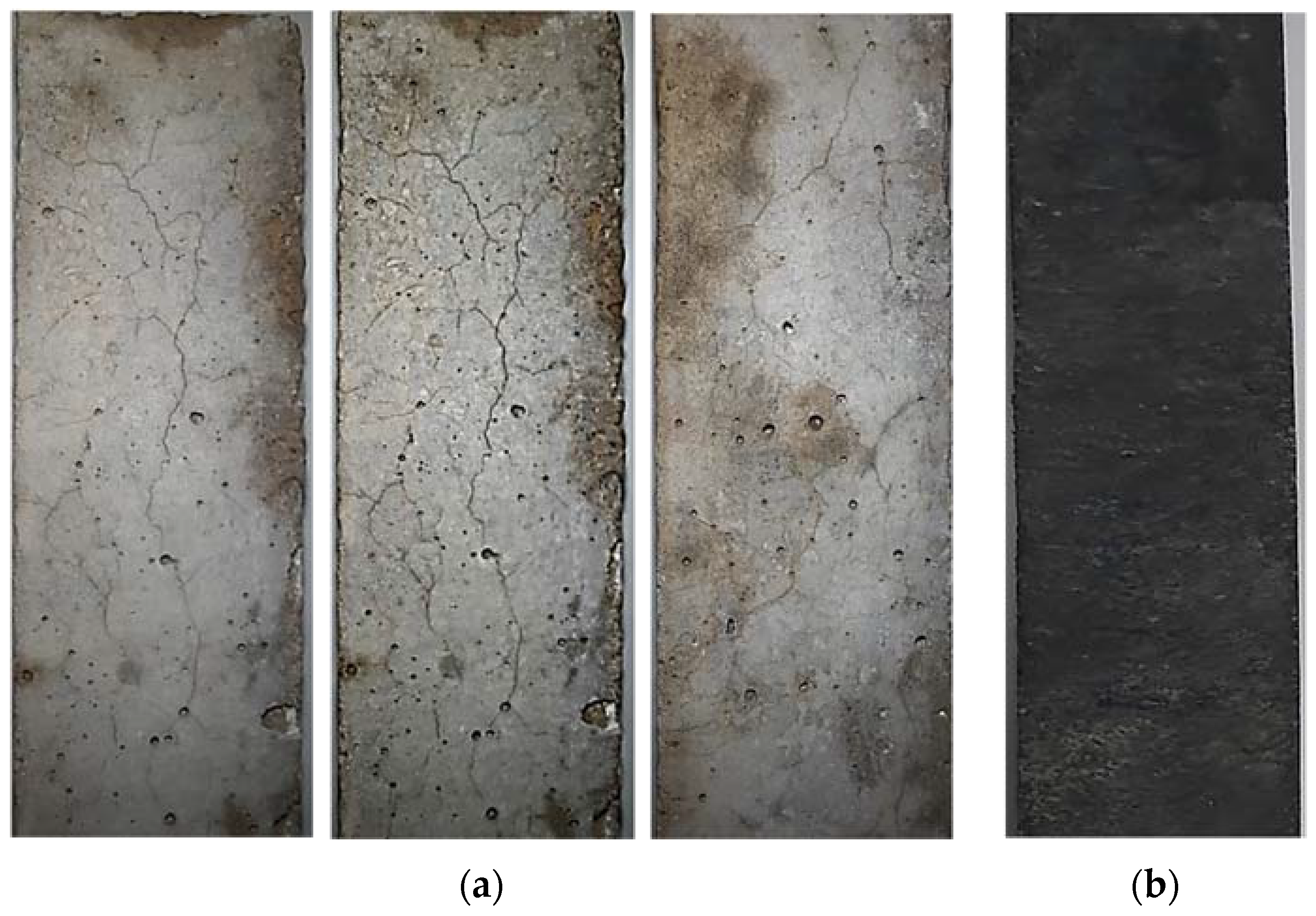
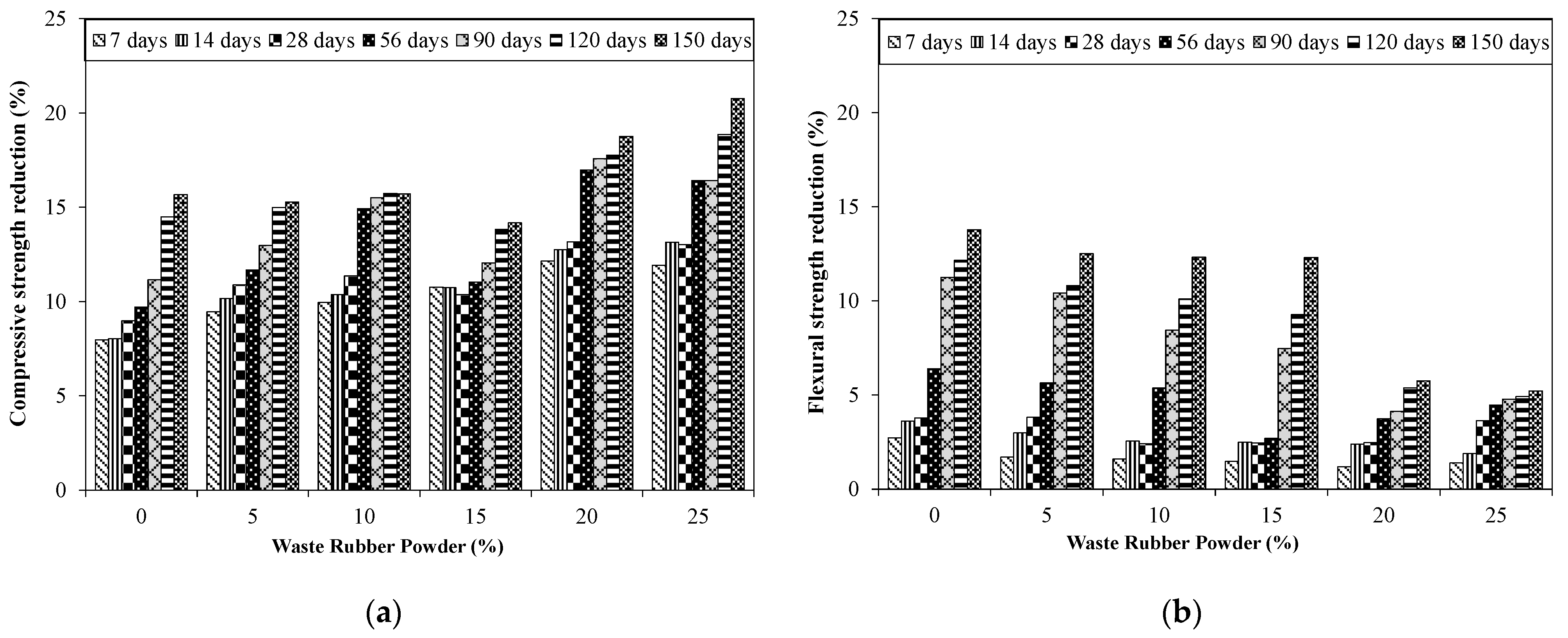

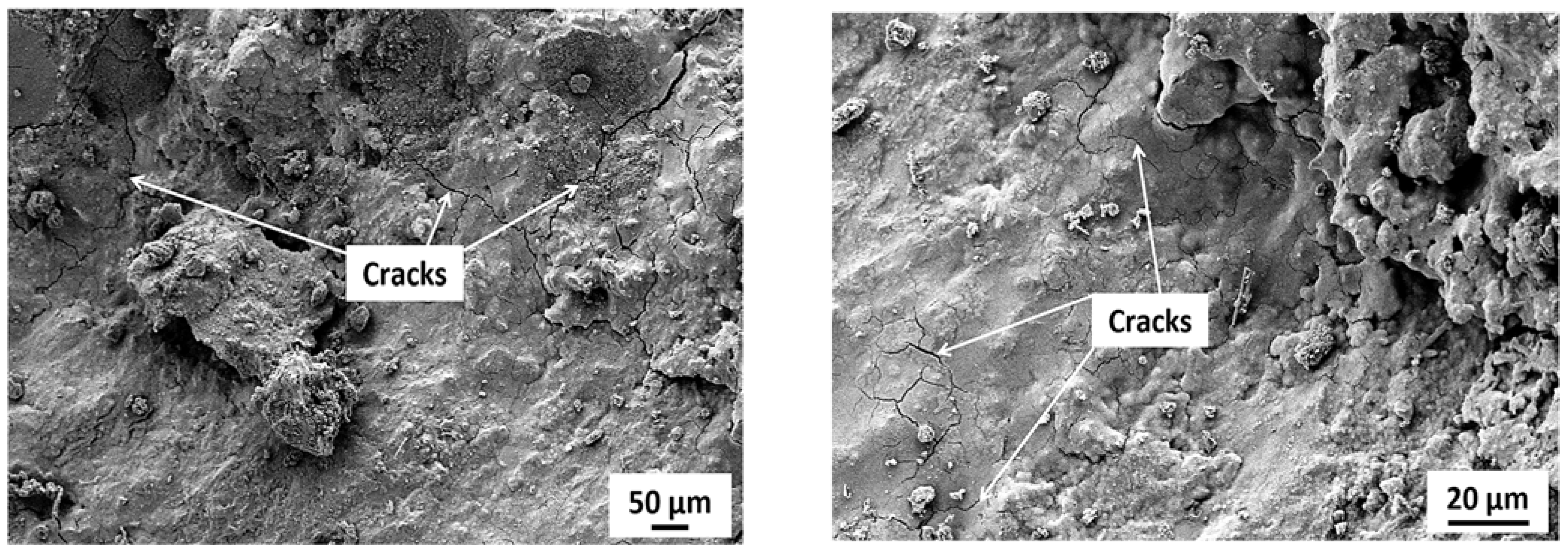
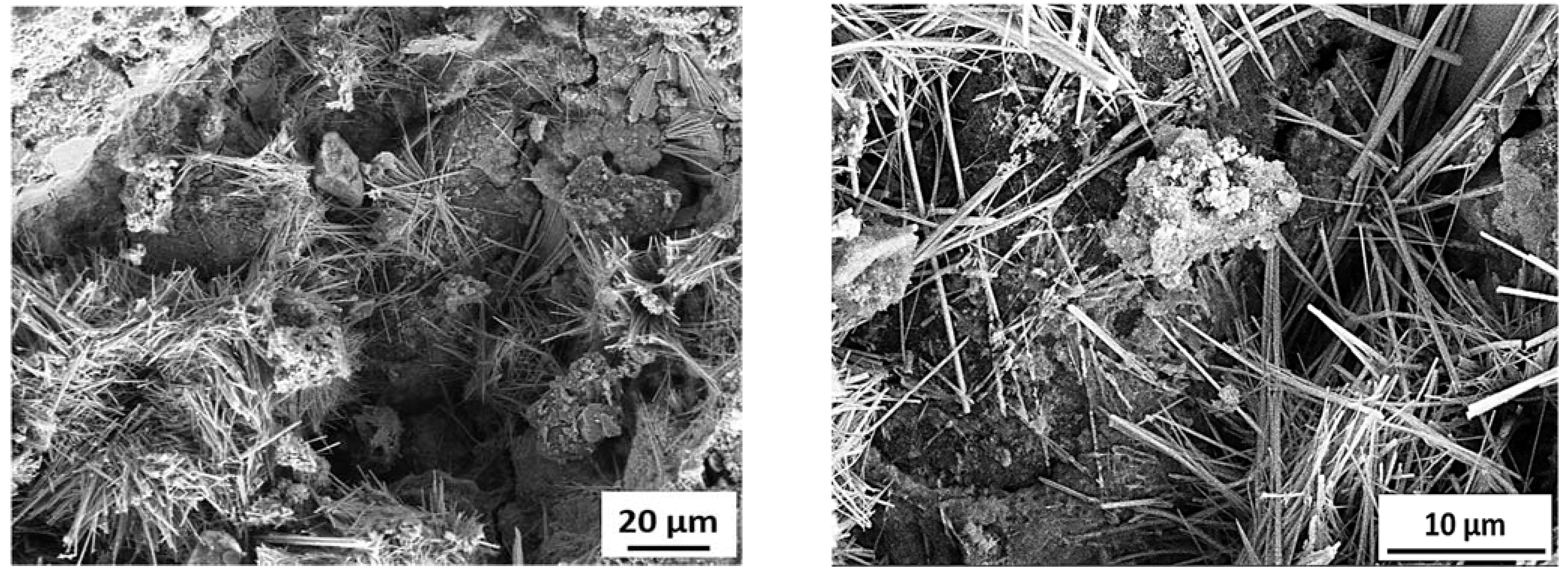
| Mixtures | Cement (%) | RW (%) |
|---|---|---|
| Control | 100 | 0 |
| RW5 | 95 | 5 |
| RW10 | 90 | 10 |
| RW15 | 85 | 15 |
| RW20 | 80 | 20 |
| RW25 | 75 | 25 |
| Elements | Percentage (%) | ||
|---|---|---|---|
| Present Study | Bisht and Ramana [53] | Angelin et al. [54] | |
| Carbon (C) | 74.83 | 87.50 | 91.50 |
| Silicon (Si) | 9.90 | 0.20 | - |
| Aluminium (Al) | 2.15 | 0.08 | - |
| Zinc (Zn) | 0.82 | 1.77 | 3.50 |
| Magnesium (Mg) | 0.26 | 0.14 | - |
| Sulphur (S) | 0.87 | 1.07 | 1.20 |
| Oxygen (O) | 11.17 | 9.24 | 3.30 |
| Components | Result (%) |
|---|---|
| CaO | 61.92 |
| MgO | 1.96 |
| SiO2 | 20.67 |
| SO3 | 2.59 |
| Al2O3 | 4.98 |
| Fe2O3 | 3.25 |
| K2O | 0.73 |
| Na2O | 0.10 |
| LOI | 2.61 |
| Properties/Tests | Cement | Recycled Rubber Waste |
|---|---|---|
| Specific gravity | 3.15 | 1.24 |
| Unit weight (kg/m3) | 1427 | 285 |
| Blaine fineness (cm2/g) | 3075 | 3944 |
| Fineness (Passing 200 sieve) (%) | >95 | >93 |
| Autoclave expansion (%) | 0.13 | - |
| Standard consistency (%) | 24.6 | - |
| Setting time (Initial, minutes) | 120 | 195 ¶ |
| Setting time (Final, minutes) | 230 | 310 ¶ |
| Tests/Components | Results | |
|---|---|---|
| Specific gravity | 2.63 | |
| Physical | Bulk density (kg/m3) | 1429 |
| Voids content (%) | 40.23 | |
| Impact value (%) | 20.81 | |
| Abrasion test (%) | 22.44 | |
| Water absorption (%) | 2.11 | |
| Chemical | Silica (%) | 75.45 |
| Calcium oxide (%) | 3.80 | |
| Magnesium oxide (%) | 2.10 | |
| Alumina (%) | 3.92 | |
| Ferric oxide (%) | 4.84 | |
| Loss on ignition (%) | 7.24 | |
| Mixtures | Flow (mm) |
|---|---|
| RW0 | 114 |
| RW5 | 110 |
| RW10 | 108 |
| RW15 | 105 |
| RW20 | 102 |
| RW25 | 101 |
Publisher’s Note: MDPI stays neutral with regard to jurisdictional claims in published maps and institutional affiliations. |
© 2022 by the authors. Licensee MDPI, Basel, Switzerland. This article is an open access article distributed under the terms and conditions of the Creative Commons Attribution (CC BY) license (https://creativecommons.org/licenses/by/4.0/).
Share and Cite
Abbas, S.; Ahmed, A.; Waheed, A.; Abbass, W.; Yousaf, M.; Shaukat, S.; Alabduljabbar, H.; Awad, Y.A. Recycled Untreated Rubber Waste for Controlling the Alkali–Silica Reaction in Concrete. Materials 2022, 15, 3584. https://doi.org/10.3390/ma15103584
Abbas S, Ahmed A, Waheed A, Abbass W, Yousaf M, Shaukat S, Alabduljabbar H, Awad YA. Recycled Untreated Rubber Waste for Controlling the Alkali–Silica Reaction in Concrete. Materials. 2022; 15(10):3584. https://doi.org/10.3390/ma15103584
Chicago/Turabian StyleAbbas, Safeer, Ali Ahmed, Ayesha Waheed, Wasim Abbass, Muhammad Yousaf, Sbahat Shaukat, Hisham Alabduljabbar, and Youssef Ahmed Awad. 2022. "Recycled Untreated Rubber Waste for Controlling the Alkali–Silica Reaction in Concrete" Materials 15, no. 10: 3584. https://doi.org/10.3390/ma15103584
APA StyleAbbas, S., Ahmed, A., Waheed, A., Abbass, W., Yousaf, M., Shaukat, S., Alabduljabbar, H., & Awad, Y. A. (2022). Recycled Untreated Rubber Waste for Controlling the Alkali–Silica Reaction in Concrete. Materials, 15(10), 3584. https://doi.org/10.3390/ma15103584






